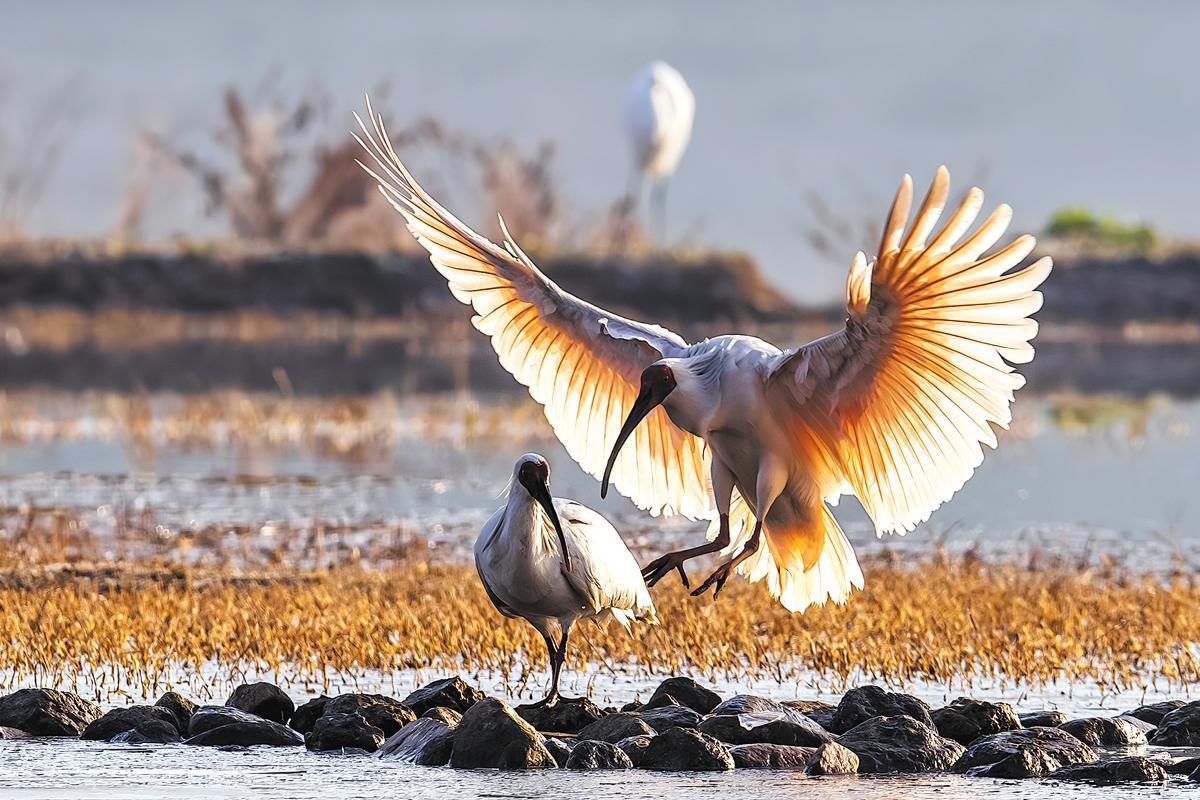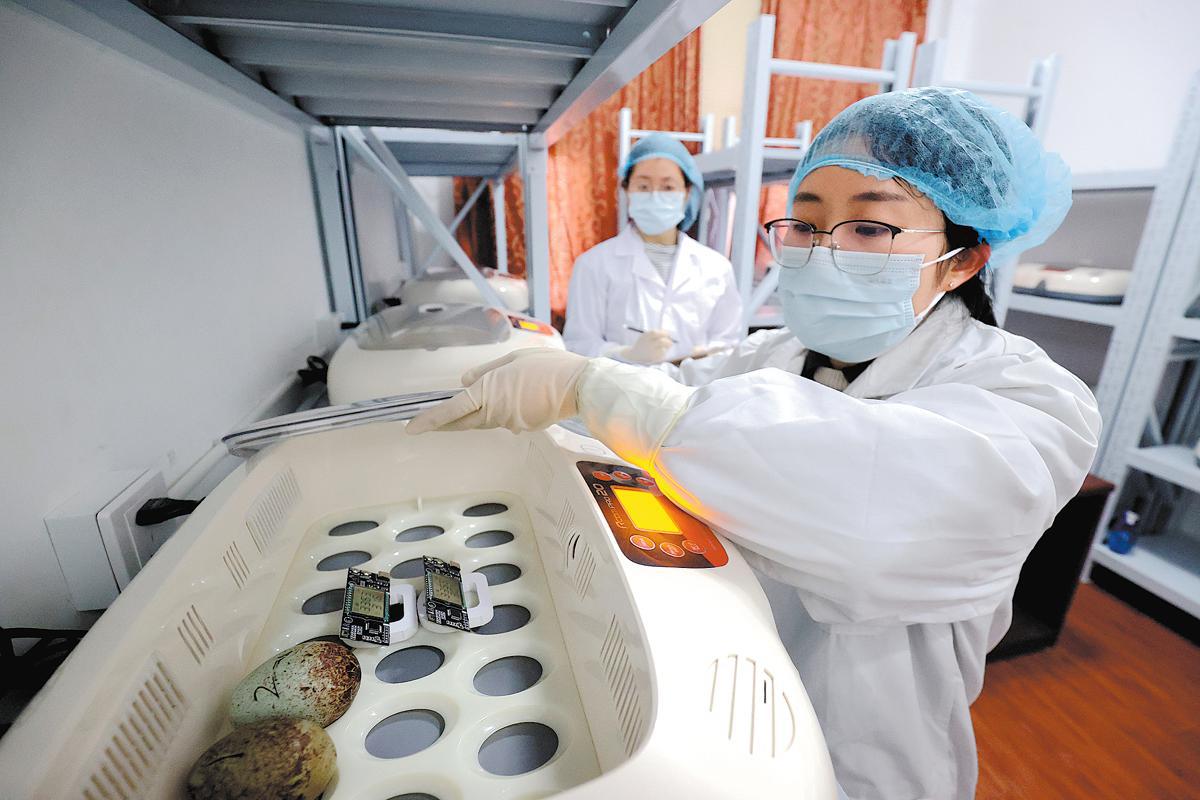Artificial breeding bolsters crested ibis population


China is continuing to make strides in its decades-long endeavor to restore the wild population of the crested ibis, a rare and endangered bird species native to East Asia and Russia's Siberia.
On June 11, during the breeding season this year, four crested ibis chicks were hatched out of an incubator and taken to the feeding area at a population reconstruction base for the species in Longhu Mountain, Jiangxi province. It was the first time that the crested ibis had been artificially bred in the province.
Officials from the base said it harvested 12 eggs of the species in May. After 26 days of natural incubation, all eggs were transferred to the incubator. Out of the five hatched chicks, four survived and, upon being moved out of the incubator, had shed their down feathers, revealing physical traits resembling those of adult birds.
Once the four chicks acquire the ability to hunt independently and fly steadily, they will be transferred to live along with the adult birds, the officials said.
Jiangxi is an important historical distribution area for the crested ibis population. Since 2023, the base has introduced 20 crested ibises in two batches from the Hanzhong Crested Ibis National Nature Reserve in Shaanxi province, hoping to reintroduce the species into the wild in Jiangxi to help rebuild the wild population.
Sometimes referred to as the "Oriental gem", the crested ibis is a critically endangered species. The species has existed for over 60 million years and was once abundant in Northeast Asia, but it was believed to have become extinct in the 1960s because of habitat destruction caused by the excessive use of pesticides and fertilizers.
In 1981, only seven wild individuals were observed in Yangxian county in Shaanxi province's Hanzhong city. Two years later, an observation station was set up in the county to protect the species, and in 2005, the State Council, China's Cabinet, approved the establishment of a nature reserve to further enhance protection of the species.
Through over four decades of conservation, the global population of the species has surpassed 10,000.
Yan'an city in Shaanxi, where 20 crested ibises were introduced in 2023, has also reported good news about artificial breeding of the bird.
In a media release on June 11, Nanniwan forest farm announced that it had successfully incubated five crested ibis chicks, emphasizing that the progress marked a breakthrough in artificial breeding technology of crested ibises in Yan'an.
Last year, the forest farm incubated three chicks.
In Hunan province, the administration of Langshan Mountain, a World Natural Heritage Site, reported in April that it had found a naturally hatched crested ibis, and its continuous monitoring showed that the chick was in good condition with a healthy appetite.
The chick was hatched atop a tall pine tree with a broad view and sparse branches. During the incubation and chick-rearing period, employees at the administration monitored the hatching process and nest conditions remotely 24 hours a day. They also regularly scattered loaches to supplement food sources for the chick, according to the administration.
In 2022, 24 crested ibises were introduced to Langshan Mountain. All of them were returned to nature after undergoing rewilding training.
Li Aiming, head of the administration, said that all of the birds had leg bands attached to facilitate monitoring after release. Since, the administration has observed 10 crested ibis chicks.
"To date, three batches of crested ibis chicks have been naturally bred in Langshan. They have laid an important foundation for the reconstruction of the population of crested ibises in the middle and lower reaches of the Yangtze River," he said.
In 2007, China achieved the world's first successful reintroduction of the crested ibis into the wild in Ningshan county, Shaanxi, where 26 of the birds were released. Their offspring made up the world's first reintroduced crested ibis population.
In Sichuan province, where 50 crested ibises were raised in 2016, an initiative to reintroduce the bird back into the wild was launched last year following the remarkable progress the province has made in artificial breeding.
The number of artificially bred crested ibises in Sichuan has reached 260. In September, the crested ibis breeding center in the province's Muchuan county started a wilding training program, successfully cultivating 28 individuals with the ability to survive in the wild. It released 12 of them on May 22, which coincided with the International Day for Biological Diversity, and plans to set free another 16 in the first half of September.

In Shandong province, a historic and sustained flight by a reintroduced crested ibis into the wild has bolstered the confidence of bird conservationists in envisioning the species' restoration in eastern China.
According to the research base for crested ibis reintroduction in the Yellow River Estuary, a crested ibis it released undertook a long-distance migration on March 19, flying nonstop for 11 hours and covering a distance of 260 kilometers.
This feat established two notable records in the annals of monitoring the migratory patterns of wild crested ibis populations in China — the longest single-day flight and the greatest continuous flight distance.
Monitoring conducted with the help of the Beidou navigation satellite system showed that the bird tagged as No 162, which is one of six of the crested ibises the administration released in October 2014, successfully crossed the Bohai Sea amid strong air currents, maintaining a speed of 30 to 50 km per hour, it said.
The intense air currents in the Bohai Strait and the absence of resting spots in its flight path posed a life-or-death test for the crested ibis, whose wingspan measures less than 1.5 meters, it underscored.
Satellite data confirmed that the bird's health remained stable after the journey, with robust vital signs recorded.
Liu Dongping, a bird expert, highlighted the remarkable navigational precision of the bird and said the No 162 crested ibis defied prior assumptions that the species could only manage short-distance flights of around 40 km.
"This migration redefines the species' potential, renewing hope for population recovery in eastern wetlands," he said.
Xinhua contributed to the story.
houliqiang@chinadaily.com.cn
- Artificial breeding bolsters crested ibis population
- Spotless tree toads could make Shanghai comeback
- Crackdown on illicit Botox courses widens
- Hunan offers healthier weight-loss meals without sacrificing flavor
- Joint air force training bolsters ties
- Adventurous souls take flight with weekend international travel




































